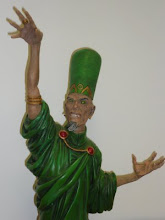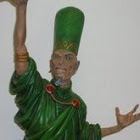 An enjoyable and engaging pulp adventure story, Fabian Gray can channel the abilities of Merlin, Robin Hood, Sherlock Holmes, Ogami Itto and Dracula thanks to the pieces of the Dreamstone embedded in his chest. The opening episode demonstrates all of their abilities as Fabian robs a castle of a jewel he hopes as supernatural powers. An explosive fight in a bookshop in Barcelona and information about a temple in Africa push Fabian off on his quest to find a cure for his sister who was locked in a coma since the event with the Dreamstone. Fabian is being hunted, thought he does not know it by someone who wants the powers he has and when Fabian and his friend Sebastian arrive in Africa to a very hostile reception the adventure kicks off into high gear.
An enjoyable and engaging pulp adventure story, Fabian Gray can channel the abilities of Merlin, Robin Hood, Sherlock Holmes, Ogami Itto and Dracula thanks to the pieces of the Dreamstone embedded in his chest. The opening episode demonstrates all of their abilities as Fabian robs a castle of a jewel he hopes as supernatural powers. An explosive fight in a bookshop in Barcelona and information about a temple in Africa push Fabian off on his quest to find a cure for his sister who was locked in a coma since the event with the Dreamstone. Fabian is being hunted, thought he does not know it by someone who wants the powers he has and when Fabian and his friend Sebastian arrive in Africa to a very hostile reception the adventure kicks off into high gear.Frank J. Barbiere has set the story in the 1930's hey day of the pulp adventure story and uses the genre with tremendous confidence to drive the story. Setting up the story premise is the easy part, using it in an interesting and engaging way is considerably more challenging. Fabian Gray has an uneasy relationship with his ghosts, they have been brought together by force not choice and there is an internal struggle going, at the same time these ghosts make him a target and he needs their abilities to survive. This is the basic problem that the story sets up and the problems are resolved in interesting and engaging ways. Frank J. Barbiere uses literary references in unexpected and clever ways to frame and add texture to the story and he never betrays the story logic that underpins the plot.
Chris Mooneyham's art is strongly expressive, the action is fast and serious, the cast move with physical force. I find it a little too stiff and angular to be very appealing, it is too sketchy for my taste, the cast are not quite rounded enough. The art pushes me a little from the story and reduces my enjoyment a small amount. The colouring by S. M. Vidaurri and Lauren Affe is very dark, this works well for the story and the intent, it fits very well with the art but seems to be a little at odds with the bright adventure of the story. There is a very minor disconnect between the overall art and the story that prevents the comic being a complete success.
This comic is well worth reading, smart writing and strong art, a excellent set up for a story with very interesting possibilities.






